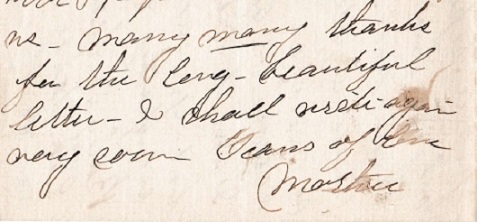and it starts...
With the happy couple living together in Lynn, there was little need to write each other. We see no more letters until this
missive, assumed to be from July or August 1910, since George labelled it with "written when Marian was first taken sick":
My dear George
I have just finished a letter to Marian and will enclose it in this so you can take it Friday. Read it over to be sure it is all right. Your ?special? came about half past nine and I was so glad to get it. My heart aches for you my boy - and my comfort is to do all I can for you. If it was not for earning the money to help you I should give up and come up to take care of you and do all I could for Marian. I am very proud of you both and I do believe Marian is going to get well and be a comparatively strong woman. I am so glad she has such a nice nurse - sometimes I mu-- see her.

Your letter touched me deeply. Do you know how nearly you are repeating Pop's experience only he had no one to help him as you have. But I firmly believe Marian will get well I think so more as her condition may account for much of this. I am to nervous to write a letter but you will read my love and sympathy between the lines.
Baby is beautiful and I think Ella takes nice care of him. She needs his crib and when I come we will send it up with his high chair and some clothes for cooler weather. Send me just a card every day. I will see about the gloves? in a little while - I can't just now. Don't worry - keep up your courage. I am always back of you. I wish Papa was here to help us. Many many thanks for the long beautiful letter - I shall write again very soon.
?Oceans? of love, Mother.

My dear George
I have just finished a letter to Marian and will enclose it in this so you can take it Friday. Read it over to be sure it is all right. Your ?special? came about half past nine and I was so glad to get it. My heart aches for you my boy - and my comfort is to do all I can for you. If it was not for earning the money to help you I should give up and come up to take care of you and do all I could for Marian. I am very proud of you both and I do believe Marian is going to get well and be a comparatively strong woman. I am so glad she has such a nice nurse - sometimes I mu-- see her.

Your letter touched me deeply. Do you know how nearly you are repeating Pop's experience only he had no one to help him as you have. But I firmly believe Marian will get well I think so more as her condition may account for much of this. I am to nervous to write a letter but you will read my love and sympathy between the lines.
Baby is beautiful and I think Ella takes nice care of him. She needs his crib and when I come we will send it up with his high chair and some clothes for cooler weather. Send me just a card every day. I will see about the gloves? in a little while - I can't just now. Don't worry - keep up your courage. I am always back of you. I wish Papa was here to help us. Many many thanks for the long beautiful letter - I shall write again very soon.
?Oceans? of love, Mother.


